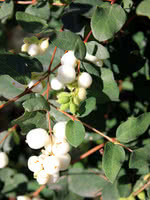Mon-Fri 9am - 5pm Mountain time
Common Snowberry vs American Hazelnut/Filbert
Symphoricarpos albus
Corylus americana
NOT AVAILABLE THIS SEASON - MIGHT RETURN
Common Snowberry is a small deciduous shrub with characteristic white to pink flowers and clusters of white fruit.
This North American native species is very adaptable, and can be used for erosion control in riparian and restoration areas. Snowberry's fruit attracts wildlife, and livestock can consume the berries without issue.
American Hazelnut is a cold hardy, disease resistant, and long-lived nut tree. It is a great choice for a shrub border for wide, open spaces where it will be allowed to spread. Typically used in naturalization projects for its spreading nature, American Hazelnut is ideal for our zone 4 customers.
If you're a zone 3 prairie customer, don't worry! American Hazelnut can still thrive but needs additional care and protection from our harsh prairie climate.
The edible nuts mature from September to October and are usually roasted or eaten fresh. Make sure you take time to notice American Hazelnut's variable and beautiful fall color that ranges from orange, rose, purplish-red, yellow, and green.
Note: You want more than one hazelnut to improve yields.
Common Snowberry Quick Facts
American Hazelnut/Filbert Quick Facts
Toxicity: berries toxic to humans

